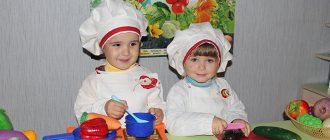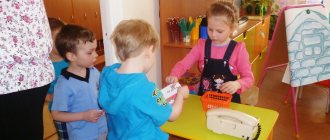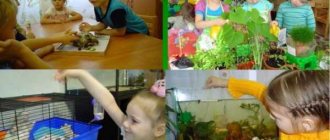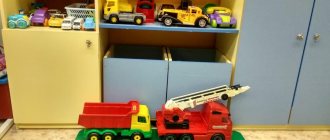PLOT-ROLE-PLAYING GAMES OF THE 21st CENTURY FOR SOCIO-COMMUNICATIVE DEVELOPMENT OF PRESCHOOL CHILDREN AGED 5-7 YEARS OLD. TECHNOLOGICAL MAPS.
OBJECT-GAME ENVIRONMENT. SCENARIOS OF ROLE-PLAYING GAMES
role-playing game for children of senior preschool age
- Technological map of the role-playing game “Weather Station”
- Technological map of the role-playing game "Detective Agency"
- Technological map of the role-playing game “Veterinary Medical
Center” - Technological map of the role-playing game "Bank"
- Technological map of the role-playing game "Pizzeria"
- Technological map of the role-playing game “Sewing Studio”
- Technological map of the role-playing game “Aerodesign Studio” (using
the “Twisting” technique) - Technological map of the role-playing game "Staff Police"
- Technological map of the role-playing game "Theater"
- Technological map of the role-playing game “Machine Maintenance
” - Technological map of the role-playing game travel agency
"Around the World" - Technological map of the role-playing game “Farmservice”
- Technological map of the role-playing game “Rescue Service”
- Technological map of the role-playing game “Choreographic
- festival"
- Technological map of the role-playing game "Circus"
- Technological map of the role-playing game "House of Fashion"
- Technological map of the role-playing game “Jewelry store
“Almaz””
Purpose of the game: formation of communicative competence.
Tasks
- Develop the ability to obtain the necessary information in communication, the ability to listen to another person, respect his opinion and interests, and the ability to conduct a simple dialogue with adults and peers.
- Improve communication skills, expand
children's vocabulary. Develop fantasy and imagination, dialogical and monologue speech.
- Introduce children to the professions of people working for
television. Practice the ability to select objects and attributes for the game. To promote the formation of the ability to change game interaction depending on changes in the plot plan.
- Encourage children to assign roles independently. Create
conditions for the development of moral and aesthetic needs, the creative potential of the child through introduction to the world of television art. Develop cultural behavior skills and friendly relationships in a group game.
Preliminary work
Excursion to television: examination of the setting of the film set and equipment, explanation of the purpose of stands, signs,
monitoring the work of television workers. Observing how TV shows are filmed. Television workers talk about their work.
Conversations with children about the media, the role of television in people’s lives: “What is television for”, “Favorite TV shows”, “What can replace a TV”, “How is a TV show filmed”, watching the presentation “Where did television come from”, “Who works on television”, watching educational and entertaining television programs.
Reading literary works by A. Barto “Strong Cinema”, “In the Cinema”, M. Zoshchenko “Actor”, M. Prishvin “The Beginning of Autumn”, B. Zhitkov “How Light Goes Through Wires”, M. Alimbayev “What a Strange Country "
Didactic games: “Cut pictures”, “What fairy tale is this from?”, “What’s missing?”, “Correspondent”, “Make a cartoon”, “Who can name more TV shows”, “Who needs what for work”, “What The director needs it."
Exhibition of children's drawings “Children's Television”, “Cinema through the eyes of children”, “Advertising for the play” (collective work), drawing signs, collective collage “On Television”.
Compilation of a mini-encyclopedia “All about television”.
Developing subject-game environment: computers, video camera, cameras, bag for television equipment, “TV”, microphone, telephone, walkie-talkie, “cracker”; symbolism of various programs; costume elements, makeup, cosmetic sets; interior elements, decorations, screens, photographs; costumes for theatrical activities, masks; logo of the program in the form of an application, identification badges for participants
filming (hosts, cameraman, reporters, guests of the program).
Construct of the role-playing game “Restaurant” under the direction of L.P. Temereva
-Children, who can work in a restaurant? (cook, waiter, administrator)The teacher listens to the children's answers.
-What work does each employee do?
(cook - cooks; waiter - brings the menu, writes down dishes, brings the order, clears the table; administrator - monitors the work of the employees, brings visitors to the table, takes reservations for tables in the restaurant.)
The teacher listens to the children's answers.
-What qualities do you think each restaurant worker should have?
(cook – diligent, careful; waiter – kind, polite, patient, attentive; administrator – kind, polite.)
The teacher listens to the children's answers
-What should visitors be like?
(kind, polite, well-mannered, patient.)
The teacher listens to the children's answers
-What do you think restaurant employees and visitors can say?
(visitors - hello, good afternoon, I would like to order, could you bring it, thank you very much, goodbye; administrator - hello, good afternoon, please come in, do you like everything, goodbye; waiter - good afternoon, please take menu, would you like to try it, I would like to recommend it to you, bon appetit, goodbye; cook - the order is ready, please take the order.)
The teacher listens to the children's answers
-What are your favorite dishes? Can they be prepared in our restaurant?
The teacher listens to the children's answers.
-Children, what do you think we might need for the game?
(menu, products, clothes, appliances, place..)
The teacher listens to the children's answers
-Which of you would like to create a menu and come up with unusual names for dishes?
-Who would like to beautifully arrange cutlery for our future visitors?
The teacher distributes responsibilities according to the wishes of the children; if several children want to do one task, then a draw is held.
-Children, we need to determine where the cook will work, where to put tables and chairs for visitors, how the waiter will write down orders.
The teacher organizes the preparation of the playing space and equipment. Provides assistance if necessary.
-Have you already chosen a place for the cook?
-How did you arrange the equipment?
-What dishes can be served in the restaurant? Let's draw a menu together?
-Now let's distribute the roles. How can we do this?
(optional, by drawing lots, counting)
The teacher listens to the children's answers.
-Can I be the restaurant administrator today?
Intended roles and game actions:
Main
The director monitors the actors and their performance. Gives commands when to start filming and when to stop.
Assistant director - invites participants and viewers to television shows.
Cameraman - films a TV show with a video camera.
TV presenter, announcer - introduce TV viewers to the news or conduct programs on various topics.
A reporter—a correspondent—conducts interviews and reports from the scene.
Design artist - draws and sets up scenery.
Photographer - takes photographs of events, compiles catalogues, sends photographs to exhibitions, creates advertising.
Spectators, television viewers - watching a film, a program.
TV show participants - participate in TV shows and give interviews. Minor
Director - hires, looks for sponsors, checks the work.
Make-up artist - applies make-up to actors.
Costume designer - dresses the actors in costumes.
Security guard - keeps order, reminds about the rules of behavior in a public place, directs visitors to the right department.
The driver brings the equipment and film crew to the scene.
Loader - loads costumes and scenery for filming into the car, helps in setting up the film set and screens.
Methodological development “Planning role-playing games in the senior group”
Elena Fedosenko
Methodological development “Planning role-playing games in the senior group”
Relevance:
Role-playing games allow you to develop creative abilities
children, their imagination and artistry, are taught to get used to the image of this or that
character, to play a certain role. They are of great importance in
social adaptation of the child, realization of his potential in the future.
By playing out various life situations, children learn to cope
compromise, make fewer mistakes in people, avoid conflict situations,
maintain a friendly atmosphere. in role-playing game
the child’s personality, his intellect, will, imagination and
sociability, but most importantly, this activity generates a desire for
self-realization, self-expression. Moreover, the game is reliable
diagnostic tool for the mental development of children.
Thus, the main goal of developing a plot-based role-playing game
is the development of the free creative personality of the child, which
determined by development objectives and research objectives
children.
Long-term plan for role-playing games
Month Name,
content Methodological work
September 1. “Shop”
(vegetable, grocery, shoe." Consolidating knowledge about the functioning of the store. Forming skills of cultural behavior in public places. Examination of photographs
"Store"
.
Conversations: “How a salesperson works”
,
“Polite Customers”
,
“Going to the Store”
;
2."Beauty saloon"
.
Teach children how to organize a game. Introduce the work of a hairdresser
Have a conversation
"How we went to the hairdresser"
,
"At the hairdresser"
. The salon has men's and women's rooms. Masters cut, shave, wash their hair, and comb their clients' hair. They are polite and attentive.
October 1. "Cinema"
Select episodes from different fairy tales where the character traits of the characters are clearly manifested. Filming the fairy tale “Little Red Riding Hood”
The wolf pretends to be a grandmother, and Little Red Riding Hood asks: “Why do you have such big ears?” etc
2 Game "Street"
Target. Teaching children to implement and develop the plot of the game . Fixing the names of cars, rules of conduct on the street and in public transport.
Themed walks - excursions along the street. Conversations using illustrative material. Watching films and fragments on the topic “Street”
.
Game roles. Pedestrians, drivers, policeman, janitor, etc.
November 1. “Ambulance”
"Pharmacy"
Introduce children to people in medical professions, teach them to respect their work. Conversation: “How we measure weight and height”
,
“What to do if you get hurt”
,
"Aibolit Hospital"
,
“What they sell in the pharmacy”
Reading fiction: “Doctor Aibolit”
2. "Family"
Learn to play out family situations, distribute responsibilities between family members. Conversation: “Who takes care of children at home, who loves children”
,
December 1. “Kindergarten”
Introduce the work of a teacher Conversation “Who is a teacher”
. The teacher meets the children, plays with them, and conducts classes.
Conversations: “How we play and practice in kindergarten
2. Game "Birthday"
Target. Cultivating sensitivity and attention. Strengthening cultural skills. Conversation about organizing a birthday party. Learning poems, inventing games, attractions.
Game roles. Birthday boy, mom, dad, grandma, grandpa, teacher, brothers, sisters, guests.
January 1 Game "Factory"
Target. Formation of labor skills, development of children's creative imagination. Formation of preschoolers’ ideas about what a plant (factory)
and what he produces Conversation about the labor of workers.
Watching fragments of a film about people in working professions. Reading the story “Automobile Plant”
from A. Dorokhov’s book
“One Hundred Obedient Hands”
.
Reading excerpts from V. Mayakovsky’s books “Who to be?”
, V. Avdienko
“All works are good”
2. “Polyclinic”
.
Introduce children to work at the clinic and the reasons for going there.
Situations: Mom brings her daughter to the doctor. The doctor sees patients, asks where it hurts, measures the temperature, and sets a thermometer. The nurse writes out a prescription, lubricates the wound, and bandages it.
February 1. Game "Mail"
Target. Teaching children to implement and develop the plot of the game . Expanding and consolidating children’s knowledge about different forms of postal communications: mail, telegraph, telephone, radio. Excursion to the post office, a short conversation with postal workers, observations of their work. Examination and reading of children's books: N. Grigorieva “You dropped the letter”
, E. S. Ya. Marshak
“Mail”
.
Showing a film or cartoon on the topic “Mail”
.
Conversation on the painting “At the Post Office”
.
2. Game "School"
Target. Teaching children to implement and develop the plot of the game . Introducing and accustoming preschoolers to the routine of school life. A tour of the school, a conversation with school employees: teacher, director, janitor, cleaner, barmaid, observing their work. Game material. Construction material, notebooks, textbooks, pens, pencils, bells, briefcases, pencil cases, cardboard.
March 1. “Transport, construction”
Introduce transport.
"Firefighters"
Explain that firefighters put out a fire, save people. Look at the illustrations and talk about them: drivers take cars, fill up with gasoline, drive carefully so as not to run into people, carry materials for construction, builders are building a garage. There are different cars driving on the street, they carry loads.
2."Police"
"Army"
.
Teach to be proud of our Motherland and its defenders.
Game "Border Guards"
Instilling in them courage and endurance. Looking at photographs and illustrations. Organize a game outside.
Reading several stories about border guards, watching a movie. Drawing on the theme “Border”
.
April 1. “Cafe”
Introduce children to those who work in the cafe. Look at the illustrations: “Who works in the cafe”
cooks purchase food from the store, prepare food, and feed visitors.
2. Game "Cosmonauts"
Target. Promoting military-patriotic training of preschool children. Improving physical fitness. Consideration of the illustrative. Reading essays about astronauts. Watching a film about astronauts. Drawing on the theme "Space"
.
May "Circus"
To consolidate children's knowledge about the circus and its workers.
Game "River Journey"
Target. Teaching children to implement and develop the plot of the game . Formation of ideas about the types of river transport, about the importance of the work of adults - river port workers for the cities and villages of the country. Reading poems about the circus.
Listening to songs "Circus Chapiteau"
,
“Clowns and children”
,
“Where did the circus go”
.
Reading the story by V. Dragunsky “The Girl on the Ball”
, E. Uspensky
“School of Clowns”
.
Conversation “Memories of the Circus”
.
Game Start Options
- th option. "TV studio". The television studio employs editors who direct the activities of all studio workers, determine the theme and plot of the programs, the order in which television programs are shown, collect the necessary information, and prepare the text. They give instructions to graphic designers to prepare the film set.
- th option. TV show “Our Favorite Kindergarten.” Design artists create a TV show logo, scenery, determine the location for the film set and design it. Correspondents go on a tour of the kindergarten and groups, conduct interviews, and compose the text of the television program. The director selects TV presenters and gives the command to start filming. The assistant director invites and places viewers in the hall. The operator sets up the equipment and prepares to shoot.
- th option. Open a competition for the selection of TV presenters, announcers and actors with subsequent employment.
- th option. “Visit to the make-up artist, costume designer.” TV presenters and actors come to the make-up artist. It changes their appearance: makeup, hairstyle. He takes them to the costume designer and explains what clothes are needed for the TV show. The costume designer and his team select clothes for TV presenters and actors in accordance with the order. TV presenters and actors thank the costume and make-up artist for a good job.
- th option. Creating problematic situations:
- opening a cafe where juice tasting and visiting a free karaoke club will be held - they turn to television workers for help;
- When a supermarket opens, a bag with a foreign object is brought in unnoticed by the children, and the children’s actions are monitored: Will they pick up the bag? Will they contact security? The attention of television workers is drawn, who are developing a program about the rules of conduct when foreign objects are detected.
The meaning of story games
The development of a little person is impossible without a variety of games. At an early age, it is enough for the baby to take a rattle in his hands and shake it. Children grow up, they are attracted to new toys, and the rules of the game become more complex. The baby strives to involve those around him in the gameplay, first his mother, then other children. The creativity in the personality of a preschooler is manifested.
A plot appears in the gaming activity: the children begin to assign playing roles and agree on the rules. Thematic role-playing games of preschoolers in the older group are already becoming more specific on the topic: not just “play with dolls,” but depict a plot scene, for example, a tea party with guests, where each child has a specific role, or act out a scene of disobedience. The child creates an imaginary situation that allows him to try on any role and feel like the main character.
The preschooler is absolutely independent in his actions: he can cut off bread with an imaginary knife, or with a small stick, imagining it as a key, open the lock on the door. The kid imagines himself in the hospital, at school, in the store, acting out various situations. The child’s self-expression manifests itself especially clearly in story-based play situations.
Experts identify role-playing games as a separate creative type, which are characterized by the mandatory presence of a plot, distribution of roles, and are subject to certain game rules. Any game process with a plot and distributed roles is a gaming activity of a team. Several people are involved here.
Significant socialization occurs precisely in joint activities, when preschoolers interact with each other in accordance with accepted roles. The baby learns the norms of social and moral behavior, and develops communication skills. The fidget learns to show independence, find a way out of complicated situations, and engage in constructive communication during conflicts. The child gains experience of behavior in different situations.
Among the characteristic features of all role-playing games of older preschoolers, many experts attribute the duality of the nature of the game process, which manifests itself in the combination of the fictional, imaginary world of adults with the reality of the actions of preschoolers in the game. For example, a baby is sitting on a chair, and at the same time in game reality this child is a bus driver.
Game objects replace in the imaginary world objects that are inherent in the world of adults. The duality of the situation allows preschoolers to receive information and acquire knowledge about aspects of reality previously unknown to them. The kid cannot cure a sick person or pull out a tooth, but in the gameplay he learns what a doctor does, how to behave in a hospital, and that helping people is good.
Game Guide
- Game content enrichment:
- arrival of a fire inspector: requirement to install a fire alarm;
- arrival of an energy company employee: inspection of electrical wiring, lighting fixtures, requirement to install cable channels.
- Adviсe:
- open a buffet or canteen for staff and TV show participants;
- good advertising is needed, an announcement of a TV show to attract TV viewers;
- production and screening of interesting and educational television programs.
- Creating problematic situations:
- What to do if your video camera breaks during filming?
- What to do if the main participant did not come to the shooting?
- I have problems with a non-standard figure and I can’t choose a dress or suit for a shoot. What to do? Who to contact?
- The power went out, what should I do? (Call the participants of the TV filming, discuss and determine a convenient time and place for filming);
- The video camera is broken, what should I do? (Call a mechanic to repair the equipment);
- The video camera has run out of film, what should I do? (Contact the director with a request to bring the film);
- The fire alarm went off, what should I do? (Organize the removal of all employees from the television studio, call the fire department).
Companion Games:
- TV shows on various topics (“My Family”, “Our City”, “School of the Future”);
- advertising of events (“Theater”, “Choreographic Festival”, “Circus”);
- advertising of enterprises (“Supermarket”, “Medical”, “Bank”, “Maintenance of machines”);
- advertising of products (“Aerodesign Studio”, “Jewellery store “Almaz”, “Pharmservice”, “Fashion House”, “Pizzeria”, “Sewing Studio”, “Communication Salon”);
- weather forecast (“Weather station”);
- summary of incidents (“Staff Police”, “Detective Agency”, “Rescue Service”);
— interviews with employees of various enterprises (“Travel agency “Around the World”, “Veterinary Medical Center”
| Due to its large volume, this material is placed on several pages: 1 |
Get text



